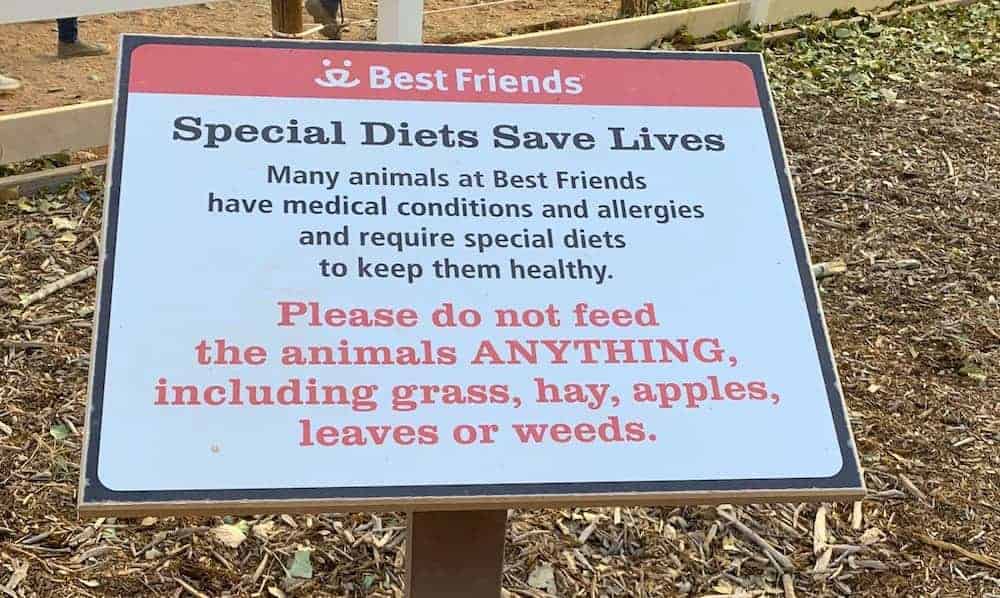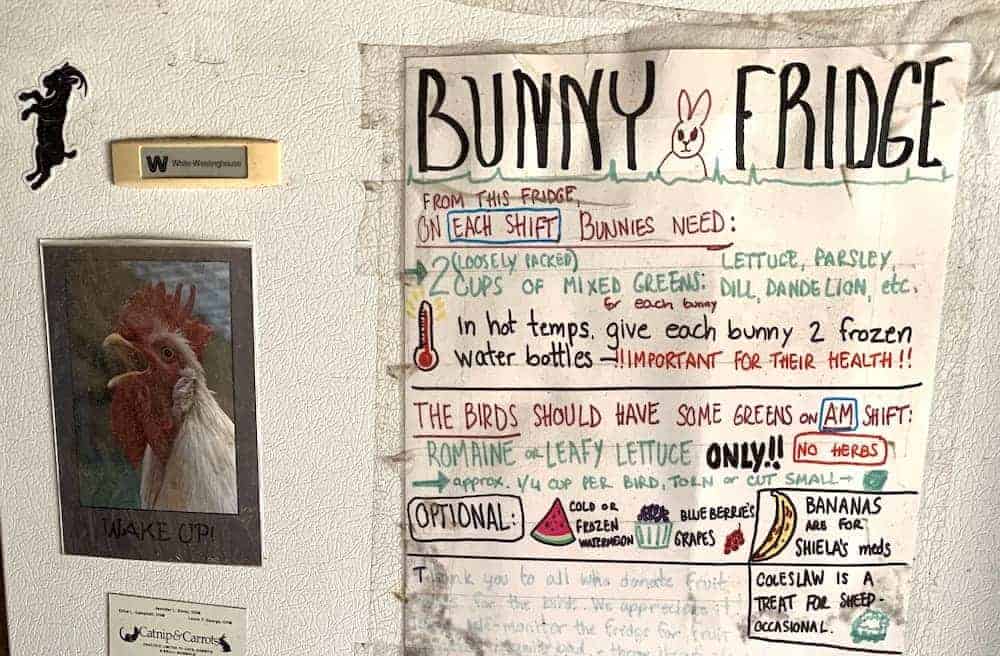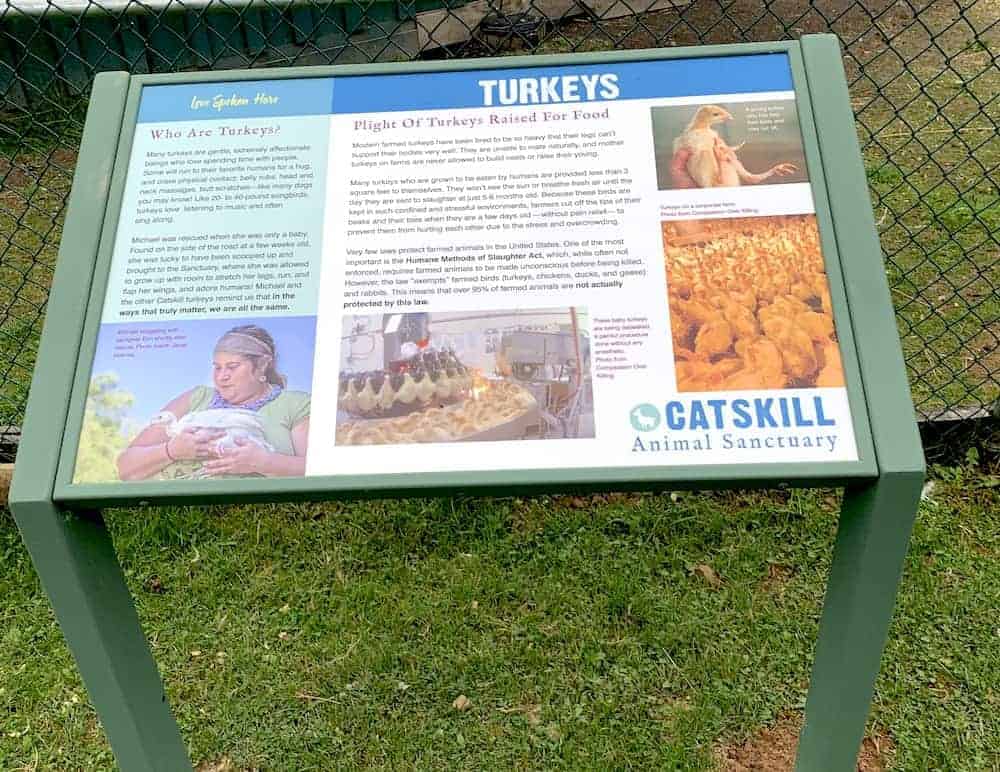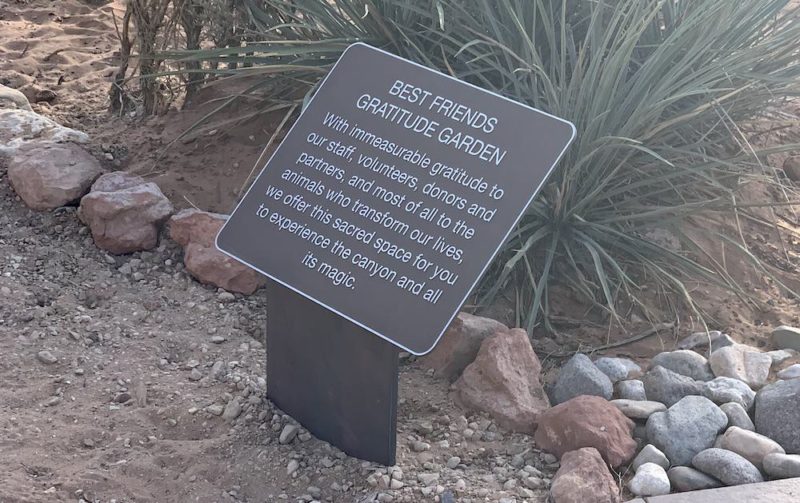
Designing and employing signage at your animal sanctuary may not seem like the most advanced or exciting topic, but it can be a valuable addition to your organization! Sanctuaries often end up creating signage as correctives to situations as they arise; this resource can hopefully help address and inform the use cases of signage before any issues arise at your organization so you can be proactive and strategic in their implementation.
Signs Can Provide Clarity

First and foremost, signs can be valuable at the basic job of providing clarity to humans of where to go, where they are, and where they should be going. Signage is an easy way to identify buildings on property and the living spaces of various residents, to explain where the bathroom for humans might be, where to park, where visitors and volunteers should go to check in, where to find representatives of your organization or where a tour might start. In more advanced cases, signage can be used to clearly identify barriers and alternative pathways for humans with disabilities. These simple signs can vastly improve a visitor experience, especially on larger or more complicated properties.
Signs Can Provide Instruction

For common instructions or guidelines that you may issue to staff or volunteers, signage is an easy way to communicate typical policies or procedures. Sanctuaries might post instructional signage on topics like food guidelines for residents, common chores for volunteers in different areas and how they are best accomplished, or signs reminding folks how to conduct simple resident care tasks that would be appropriately conveyed passively. These can provide helpful shorthand on days when a caregiving lead doesn’t have the luxury of being around less experienced volunteers at all times!
Signs Can Improve Safety For Everyone
Signage is an easy, reliable way to communicate safety instructions to humans who may be visiting your sanctuary without immediate supervision. Signs can easily instruct visitors on areas that should be avoided by visitors, such as isolationIn medical and health-related circumstances, isolation represents the act or policy of separating an individual with a contagious health condition from other residents in order to prevent the spread of disease. In non-medical circumstances, isolation represents the act of preventing an individual from being near their companions due to forced separation. Forcibly isolating an individual to live alone and apart from their companions can result in boredom, loneliness, anxiety, and distress. and quarantineThe policy or space in which an individual is separately housed away from others as a preventative measure to protect other residents from potentially contagious health conditions, such as in the case of new residents or residents who may have been exposed to certain diseases. areas, loft area safety, or other sensitive or dangerous parts of your property. Signage can also be created to provide guidance in case of emergencies, such as having lighted signs pointed to exits or explaining the location of fire extinguishers, first aid kits for humans, or emergency eye wash stations.
Signs that discourage visitors from feeding residents without strict supervision is a common sight at sanctuaries, which can be particularly valuable if your organization regularly hosts folks who may be used to different kinds of animal organizations, like petting zoos, where such behavior may be more typically permitted of visitors. They can also be implemented in areas where residents may be less comfortable around humans to discourage any interaction that could cause stress or harmThe infliction of mental, emotional, and/or physical pain, suffering, or loss. Harm can occur intentionally or unintentionally and directly or indirectly. Someone can intentionally cause direct harm (e.g., punitively cutting a sheep's skin while shearing them) or unintentionally cause direct harm (e.g., your hand slips while shearing a sheep, causing an accidental wound on their skin). Likewise, someone can intentionally cause indirect harm (e.g., selling socks made from a sanctuary resident's wool and encouraging folks who purchase them to buy more products made from the wool of farmed sheep) or unintentionally cause indirect harm (e.g., selling socks made from a sanctuary resident's wool, which inadvertently perpetuates the idea that it is ok to commodify sheep for their wool)..

Signs can also be used to explain basic safety precautions to humans who might not be familiar with them (or who could use a reminder!), for things such as reminders to always double latch any gates they might cross, or to only bring water beyond certain areas for human and resident safety. Some safety signage may be suggested (or even required) to satisfy OSHA requirements in the United States.
Some sanctuaries will have different signage for different quarantine situations, ranging from signage stating “booties required” to “full isolation gear and quarantine tools only beyond this point”, depending on what an incoming resident might be coping with. This can help keep staff informed and safe when working with quarantined residents.
Signs Can Provide Passive Education Benefits

Signage can be an excellent way to provide educational context to what a visitor may be seeing without the need for a sanctuary representative or volunteer tour guide to be physically present to explain information about the residents or the plight of those like them. While a thoughtfully delivered tour script may provide more information with greater nuance and adaptation to audience needs, educational signage is a great way to ensure that anyone who might be walking by without a tour guide has the opportunity to learn, rather than be stuck making assumptions. In farmed animal sanctuariesAnimal sanctuaries that primarily care for rescued animals that were farmed by humans., such signage might be especially valuable as visitors who aren’t visiting accompanying a tour guide may reach the opposite conclusion than your educational program may be wishing to teach without a way of contextualizing what they’re looking at.
Sanctuaries have developed educational signage for a variety of topics, from the issues inherent in backyard chickenThe raising of chickens primarily for the consumption of their eggs and/or flesh, typically in a non-agricultural environment. care and egg production and the challenges facing woolen residents, to the ethical and sustainability issues inherent to the production of cow’s milk for human consumption.
Educational signage can also be employed to introduce individual residents and their stories nearby their living spaces, including the things that they get to experience at your organization that might be markedly different than how they were living previously.
Educational signage can also help to explain organizational decisions that may not be clear at first glance to someone outside of your organization. For instance, if your sanctuary keeps some living spaces free of residents in case someone needs to be quickly isolated or removed from a social situation, it can be helpful to put up signage explaining that it is intentionally left open as a matter of safety for residents, so folks visiting without context do not assume that your organization has more capacity for responsible care than it seems!
Signs Can Demonstrate Your Gratitude

Many sanctuaries employ signage as a way to express gratitude to their supporters, especially those who have made major financial contributions to the organization. Signage for donors and to thank supporters can take many forms, from plaques on walls to donor gardens and more! For some ideas on donor gratitude and the forms it can take, check out our resource on raising money for animal sanctuaries here!
What does your organization use signs for? Anything we haven’t covered? Let us know and we’ll add it into this resource!
References To Outside Organizations?
This resource contains links or photos provided by an outside animal-focused organization. You can learn about our organization’s position on endorsements here!








